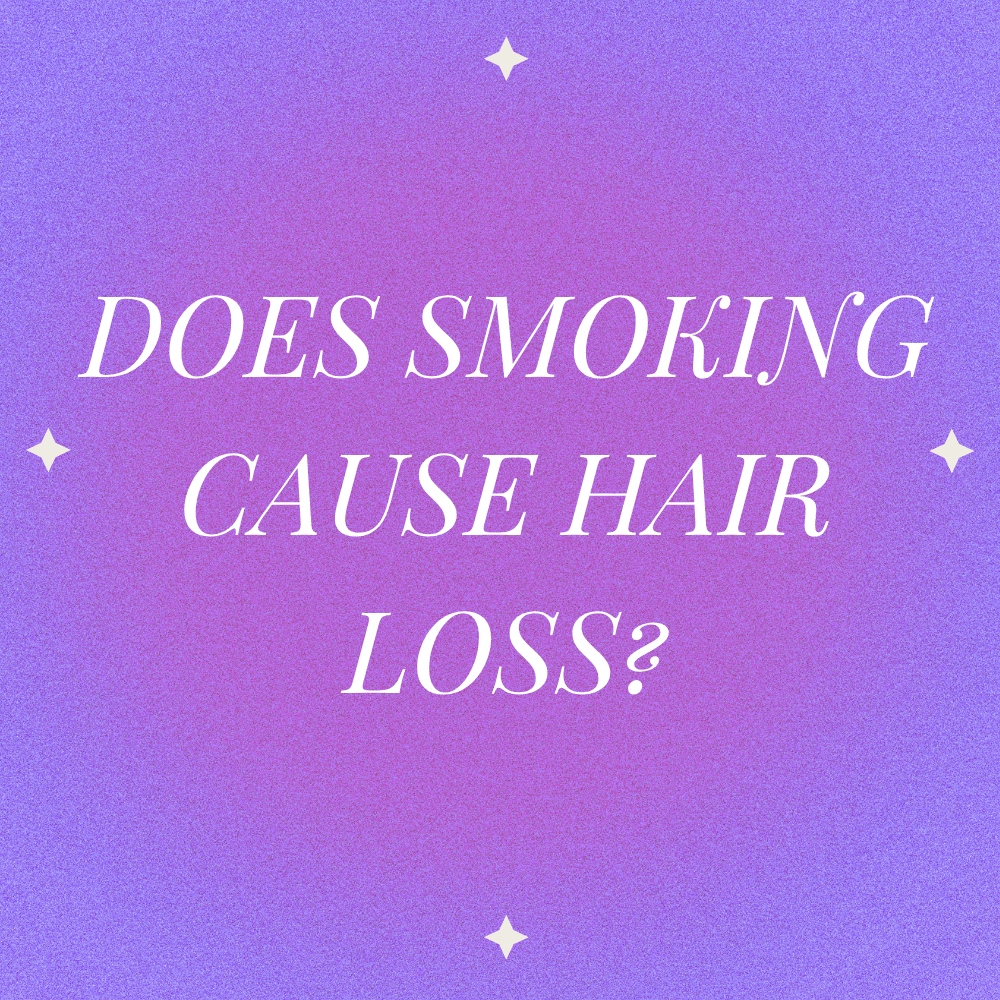Table of Contents
Top Answer: Yes, smoking has been scientifically linked to increased hair loss—especially androgenetic alopecia. It damages hair follicles through oxidative stress, restricted blood flow, hormone disruption, and DNA damage. As someone who used to smoke and battled early hair thinning, this post combines cutting-edge science from Manchester Clinic with my own recovery to help you understand what really happens when smoke meets scalp.
What the Studies Say — Smoking & Hair Loss
The science is clear: smoking drastically raises the risk of hair loss.
- A 2024 meta-analysis found that male smokers were 1.82x more likely to develop androgenetic alopecia (AGA) compared to non-smokers. Heavy smokers (10+ cigarettes/day) had a nearly 2x risk increase.
- Over 80% of smokers aged 20–35 showed signs of hair loss, versus just 40% of non-smokers.
- Smoking can worsen existing hair conditions and accelerate balding progression.
“When I first started thinning at the temples, I had no idea that the cigarettes I smoked years before were still echoing through my hairline.” — Stephi LaReine
Mechanisms:
- Constriction of scalp blood vessels (vasoconstriction)
- Reduced nutrient & oxygen delivery to follicles
- Increased DHT sensitivity (a key driver of male & female pattern baldness)
- Free radical damage to follicle DNA
1. Vasoconstriction: Cutting Off the Lifeline to Your Hair
Every strand of hair is fed by a complex system of tiny blood vessels just beneath your scalp. These capillaries deliver oxygen and nutrients—the lifeblood of your hair follicles. Nicotine narrows these vessels like a vice, reducing blood flow. The result? Your follicles are choked, underfed, and under-oxygenated. Over time, they become sluggish and stop producing hair altogether. You’re essentially starving your scalp every time you light up.
If you’ve ever felt like your scalp feels colder or looks paler, this might be why. It’s not just your heart at risk—it’s your hair too.
2. Oxidative Stress: Rusting Your Hair From the Inside Out
Cigarette smoke unleashes a swarm of free radicals—highly reactive molecules that attack your cells. These free radicals damage the DNA in your hair follicles, break down collagen, and disrupt the hair growth cycle. In healthy follicles, hair moves through the anagen (growth) phase for years. But with repeated oxidative stress, follicles are prematurely pushed into catagen (death) phase. You’re literally aging your hair at warp speed.
Think of it like rust forming on iron—but in your scalp. Over time, the damage accumulates until the structure can no longer hold.
3. Hormone Disruption: Fueling Hair Loss on a Hormonal Level
Smoking has been shown to increase levels of dihydrotestosterone (DHT)—the hormone most closely linked with androgenetic alopecia. It also decreases estrogen levels in women, worsening hair thinning. This hormonal one-two punch disrupts the delicate balance needed to maintain strong, thick hair. It’s especially risky for women with PCOS or hormonal imbalances.
For me, this was the hidden killer. I didn’t realise my hormones were being tweaked by every puff—and my hair was paying the price.
4. Follicular Fibrosis: Turning Hair Follicles Into Scar Tissue
Repeated inflammation caused by smoke exposure leads to a condition called perifollicular fibrosis. That’s when the area around each follicle becomes scarred and hardened. Unlike temporary shedding, fibrosis is permanent. Once a follicle is scarred over, it can no longer grow hair. This isn’t thinning. It’s follicular death.
“Tobacco smoke induces follicular microinflammation and fibrosis through oxidative stress and cytokine release.” — Dr. Ralph Trüeb, Dermatology Journal, 2003
And when it gets to this point, no serum, shampoo, or supplement will bring it back. This is why prevention matters more than perfection.
Can Quitting Smoking Reverse Hair Loss?
Quitting smoking is one of the most powerful, accessible things you can do to improve your hair health — but timing matters. The earlier you stop, the more likely you are to undo the damage before it becomes permanent.
Here’s what happens when you quit:
- Circulation improves within weeks
Once you stop smoking, your blood vessels begin to widen and relax. This allows more oxygen and nutrients to reach your scalp — exactly what your follicles need to regrow hair. - Inflammation drops
Without the constant flood of free radicals, your body can repair oxidative damage and calm inflammation in the scalp. This helps prevent further follicle degradation and slows hair shedding. - Estrogen stabilizes (especially in women)
Smoking disrupts hormonal balance by increasing DHT and lowering estrogen. When you quit, these levels can normalize, which is critical if you have PCOS or other hormone-sensitive conditions. - Follicles can reboot
If the follicles haven’t been permanently scarred by fibrosis, they can re-enter the anagen (growth) phase within 3–6 months. This is your window for regrowth.
“When I quit smoking, I started cooking compulsively to use up the anxious energy. It worked. Cravings disappeared. And within a few months, I definitely saw a reduction in my hair loss — considering I already had high testosterone levels due to PCOS.”
— Stephi LaReine
Your Action Plan After Quitting:
1. Test your hormones
Get a blood test (or DUTCH test) to check levels of testosterone, estrogen, and DHT. This will help you determine if your hair loss is hormonally driven — and what to do next.
2. Stimulate your scalp
- Minoxidil (topical): Helps kick-start follicles back into the growth phase. Use consistently for at least 3 months.
- Microneedling or PRP therapy: Boosts circulation and collagen around follicles, improving density and thickness.
3. Consider DHT blockers
- For women: Spironolactone can lower androgen levels and is often used in PCOS cases.
- For men: Finasteride blocks DHT, one of the primary drivers of male pattern baldness.
4. Rebuild from the inside out
- Prioritize protein, omega-3s, collagen, zinc, biotin, and iron.
- Stay hydrated. Add a pinch of sea salt or electrolytes to your water to support adrenal recovery and mineral balance.
5. Manage stress (without a cigarette)
- Walk. Meditate. Lift weights. Journal. Or cook — like I did.
- Find rituals that soothe the same craving without causing damage. Your nervous system and your follicles will thank you.
And if you’ve tried everything?
If you’ve quit, healed your hormones, nourished your scalp, and still haven’t seen results — then it may be time to explore hair transplants, red light therapy, or even exosome treatments. But the foundation starts with quitting smoking and restoring the health of your body first.
“The biggest myth is that nothing works. The truth is, a lot can work — if you quit early enough and rebuild smartly.”
Vaping, Weed & Hair Loss: Are They Safer?
In short: not really. While they might feel less toxic, vaping and weed are not hair-safe substitutes.
Vaping still delivers nicotine, the same vasoconstrictive compound found in cigarettes. This means blood vessels in your scalp still shrink, nutrient delivery remains limited, and oxidative stress is still a real concern.
The fancy vape packaging doesn’t change the biology: nicotine is nicotine. Your follicles don’t care if it comes in a USB stick or a cigarette.
Additionally, the chemical additives in e-liquids (like propylene glycol and artificial flavors) may contribute to low-grade inflammation. Some e-liquids also include substances that may disrupt hormones over time—a subtle but serious risk for those already struggling with PCOS, thyroid issues, or testosterone sensitivity.
Cannabis, while seemingly more natural, isn’t off the hook either:
- Chronic use has been shown to raise cortisol levels, a stress hormone that can push hair into the shedding (telogen) phase.
- It may also elevate testosterone, which can increase DHT production in susceptible individuals—especially women with hormonal imbalances.
- Anecdotally, some users notice worsened thinning over time when cannabis is combined with poor diet, sleep, or elevated stress.
“Don’t assume your vape is a get-out-of-balding-free card. If it spikes your DHT and chokes your scalp—it still counts.”
So what’s safer?
- Quitting completely is best, but if you must transition, try nicotine-free vape options while supporting your body with antioxidant-rich foods and hormone-balancing nutrients.
- Be cautious with regular THC use. If you’re dealing with hormonal acne, PCOS, or hair thinning, track how cannabis affects your skin and scalp.
Hair is a symptom. Your follicles reflect your internal chemistry. Don’t trade one trigger for another just because it smells like mango.
Final Words: What I Wish I Knew When I Was a Smoker
If I could go back, here’s what I’d tell myself:
- Your hair is not just about shampoo. It’s blood flow. Hormones. Mitochondria.
- Every cigarette is a micro-attack on your follicles.
- The science doesn’t lie: quitting might save your hairline.
FAQ
Yes — scientific research shows a strong link between smoking and hair thinning in both men and women. Studies confirm that smokers have significantly higher odds of developing androgenetic alopecia (AGA). This is due to smoking-induced vasoconstriction (which limits blood flow to follicles), oxidative stress (which damages DNA and proteins in the hair root), and hormone disruption — especially increased DHT levels and lower estrogen.
It depends on the severity of damage. If hair follicles haven’t been permanently scarred, quitting can reduce inflammation, improve circulation, and allow the hair cycle to normalize. Many ex-smokers report regrowth or thickening within 3–6 months. However, if fibrosis has occurred, regrowth may be limited or require treatments like microneedling, minoxidil, or hair transplants.
Yes — although vaping might seem less harmful, it still contains nicotine. Nicotine restricts blood flow and stresses your follicles in the same way cigarettes do. E-liquids can also contain compounds that cause inflammation or hormonal changes. Bottom line: vaping is not a hair-safe alternative.
You may see early improvements in blood circulation within 2–4 weeks of quitting. Hair regrowth, however, follows the natural hair cycle and usually becomes noticeable after 3–6 months. Full results may take up to 12–18 months depending on genetics, hormone balance, and overall health.
Possibly. Although cannabis doesn’t directly damage hair like nicotine, it may indirectly influence hair health by raising cortisol and testosterone levels in some users. These hormonal shifts can contribute to hair thinning, especially in those predisposed to androgenetic alopecia. Chronic use may also impact sleep, appetite, and stress — all of which play a role in hair growth.
People Also Ask
Q: What is the connection between smoking and hair thinning?
A: Smoking damages hair follicles by reducing blood flow, introducing oxidative stress, and altering hormones like DHT and estrogen.
Q: Can smoking cigarettes cause permanent hair loss?
A: Yes. Long-term smoking can lead to scarring of the follicles (follicular fibrosis), which makes hair loss permanent.
Q: Is hair loss from vaping the same as from smoking?
A: Similar. Vaping still delivers nicotine, which restricts circulation and stresses follicles, contributing to hair loss.
Q: What happens to your hair when you quit smoking?
A: Circulation improves, inflammation decreases, and if the follicles aren’t scarred, many may re-enter the growth phase.
Q: Does cannabis use affect hair regrowth?
A: It can. Chronic weed use may affect hormones like testosterone and cortisol, which influence the hair cycle.
So, does smoking cause hair loss? The evidence says yes — and it’s one of the most overlooked contributors to premature thinning
Sources & Research Table
| Source | Key Finding | Link/Reference |
|---|---|---|
| Gupta et al. (2024, Meta-analysis) | Smokers are 1.82x more likely to develop AGA | [27†Meta-analysis] |
| Dr. Trüeb (2003) | Smoking causes follicular inflammation and fibrosis | [29†Trüeb] |
| Lloyds Pharmacy (2023) | Quitting restores blood flow and may promote regrowth | [26†Lloyds] |
| Healthline / MNT | Smoking increases free radicals & oxidative stress | [30†MNT] |
| NiQuitin Study | 47% of smokers had advanced hair loss vs. 10% of non-smokers | [33†NiQuitin] |
| PMC Systematic Review | Smoking disrupts hormones, raises DHT | [31†PMC] |


